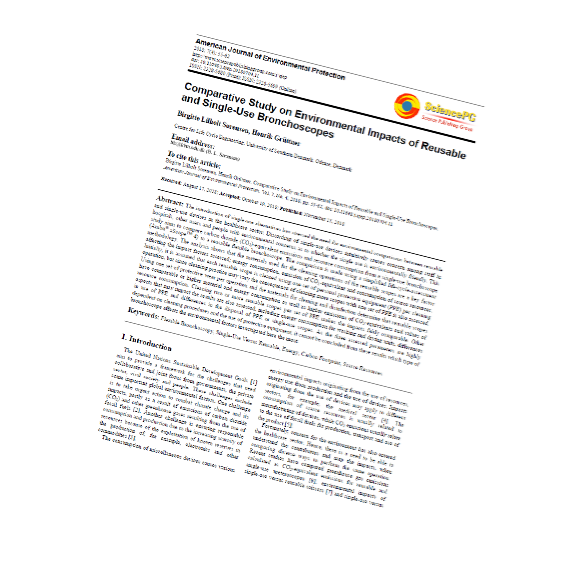Environmental impact of using endoscopes
We often hear the question “Isn’t it better for the environment to use a reusable endoscope?” and we decided to put it to the test. That is why leading environmental professors from the University of Southern Denmark have investigated the impact of single-use bronchoscopes compared to the complex and resource demanding cleaning process of reusable bronchoscopes.2-5
Reprocessing of reusable endoscopes
The amount of disposable equipment and detergents used for reprocessing one reusable endoscope can be surprising for many. The picture illustrates an example of how much material is actually needed for cleaning one reusable endoscope.1
Complexity has a cost
Recently the US Center for Disease Control and Prevention (CDC) has published a new and more extensive guidance for the reprocessing of reusable endoscopes.2 The CDC is not alone; more and more national agencies and local institutions introduce strict(er) guidelines to minimise the risk of cross contamination and enhance patient safety.3-5
These guidelines call for extensive use of personal protection equipment and detergents, resulting not only in increased reprocessing costs but also in higher environmental burdens. This trend enables us to more confidently say that, from an environmental impact, there is not much difference between a reusable and a single-use bronchoscope – perhaps it may even be less impactful to choose the single-use?
“The use of cleaning materials and personal protective equipment determines that reusable bronchoscopes have comparable or higher material and energy consumption as well as emissions of CO2-equivalents and value of resource consumption to Ambu® aScope™ 4 Broncho single-use scopes.”6
The value of resources
Value of scarce resources in aScope™ 4 Broncho and materials used to reprocess reusable bronchoscopes.4
Materials used
Embodied energy in the materials of aScope™ 4 Broncho and materials used to reprocess reusable bronchoscopes.4
CO2-emission
CO2-emission related to aScope™ 4 Broncho and materials used to reprocess reusable bronchoscopes.6
Perspectives
CO2 emissions, scarce resources, materials, etc. can be difficult to relate to – numbers can seem either very high or very low. We have put some of the numbers into perspective by relating them to activities we all know and understand.
Disposal of 1 aScope is equivalent to the disposal of 349 g of household waste7

1 aScope

349g household waste
CO2 emission equals
Everyday thousands of passengers fly from NYC to LA or the other way around making it one of the busiest air routes in the US.
The combined CO2 emission of 271 aScope 4 Broncho* equals one passenger flying one-way from LA to NYC**.
Or you can say that 271 bronchoscopies using aScope 4 Broncho have the same CO2 impact as the one passenger on the flight from LA to NYC.
* Both production and disposal
** According to Simapro version 8.4.1.4 one person flying one km corresponds to 0.11 kg CO2

Read the study
In November, 2018, the American Journal of Environmental Protection published the results of their research: Comparative Study on Environmental Impacts of Reusable and Single-Use Bronchoscopes.
Read the study here.
References
Ofstead CL, Quick MR, Eiland JE, Adams SJ. A Glimpse At The True Cost Of Reprocessing Endoscopes: Results Of A Pilot Project. www.bostonscientific.com [Internet]. 2017; Available from: https://www.bostonscientific.com/content/dam/bostonscientific/uro-wh/portfolio-group/LithoVue/pdfs/Sterilization-Resource-Handout.pdf
Center for Disease Control and Prevention. Essential Elements of a Reprocessing Program for Flexible Endoscopes – Recommendations of the Healthcare Infection Control Practices Advisory Committee. 2016;1–12.
AAMI. American National Standard - Flexible and semi-rigid endoscope processing in health care facilities. 2015; Available from: https://my.aami.org/aamiresources/previewfiles/ST91_1504_preview.pdf
SGNA. SGNA Standards: standards of infection control in reprocessing of flexible gastrointestinal endoscopes. Gastroenterol Nurs [Internet]. 2012;33(1):70–80. Available from: https://www.sgna.org/Portals/0/Education/PDF/Standards-Guidelines/sgna_stand_of_infection_control_0812_FINAL.pdf
AORN. Guidelines and Tools for the Sterile Processing Team. 2018.
Sørensen B. L. and Grüttner H. Comparative Study on Environmental Impacts of Reusable and Single-Use Bronchoscopes. AJEP, 2018; 7(4) 55-62. Available from http://www.sciencepublishinggroup.com/journal/paperinfo?journalid=163&doi=10.11648/j.ajep.20180704.11
Nielsen, Thyge M. et al. 2016; Affalds-sortering på Gentofte Hospital.






